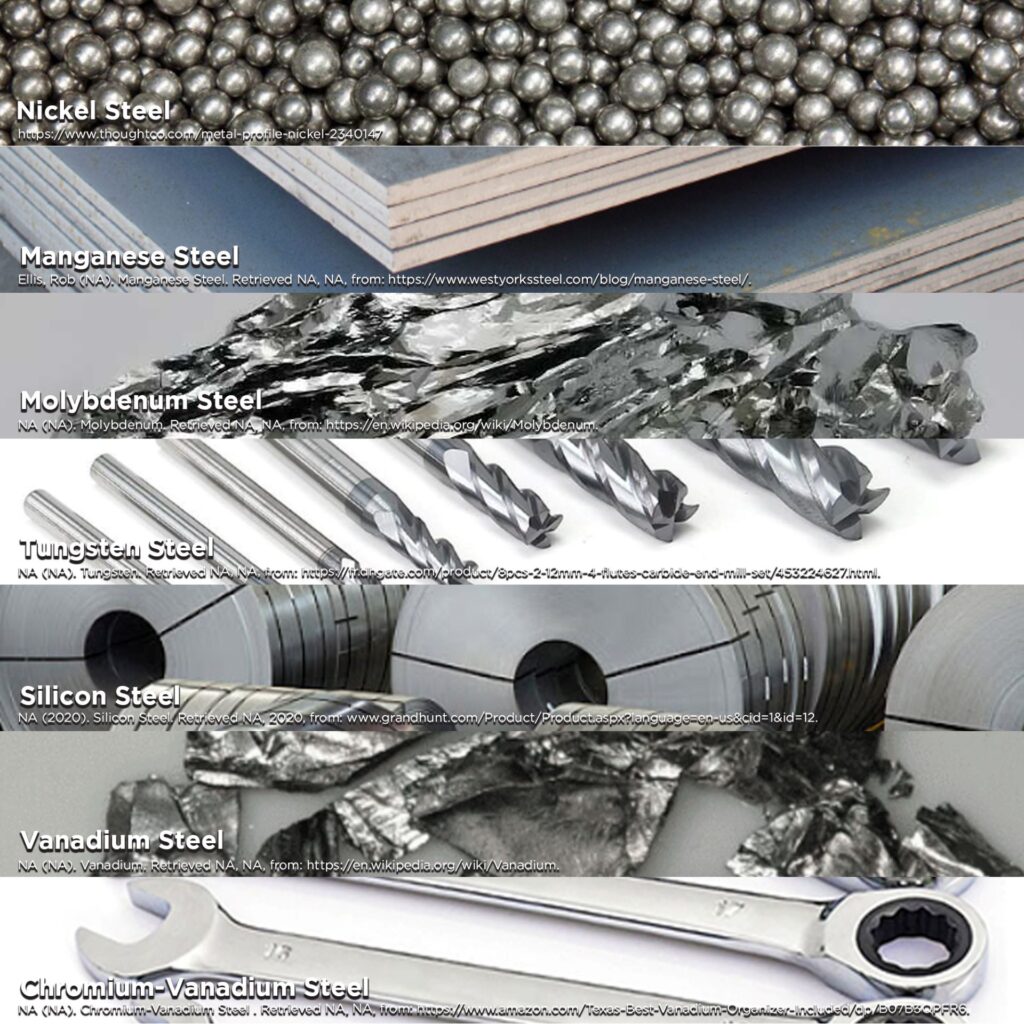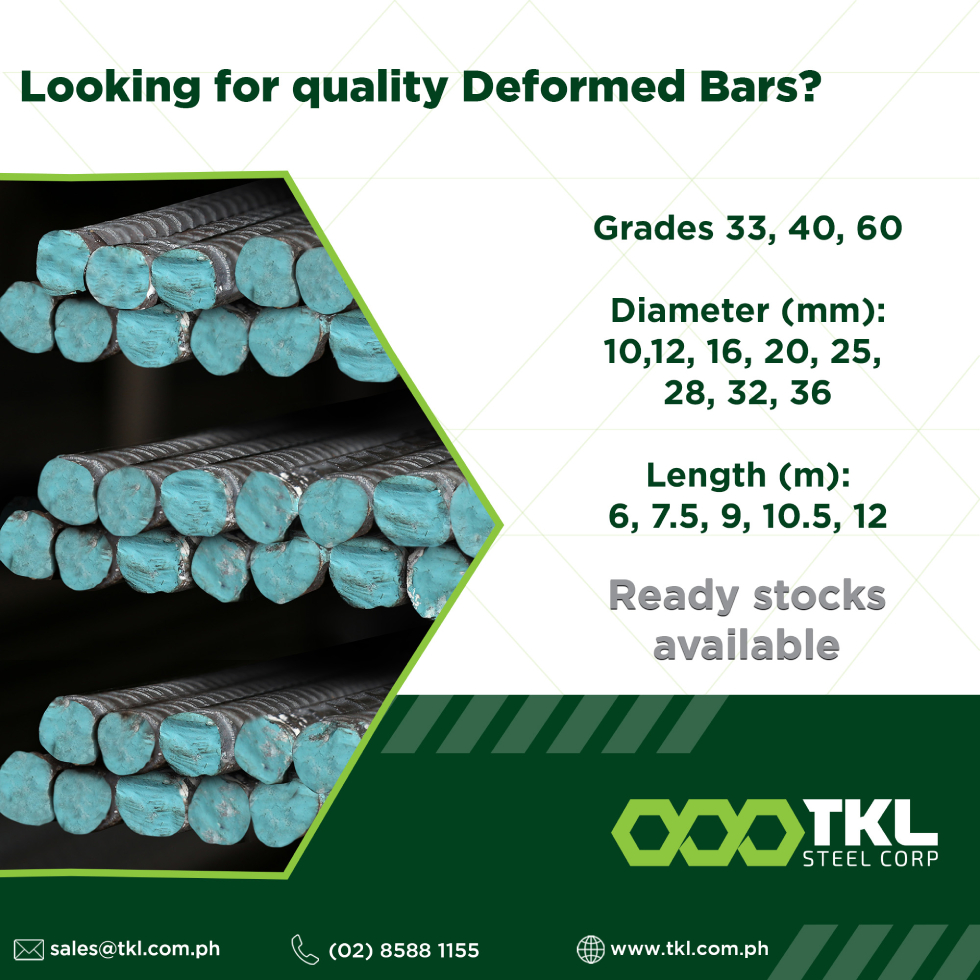Steel is an alloy that contains up to 2% of carbon, the most important commercial component of steel. There are many types and classification of steel – some look at its chemical composition, properties, or uses. Focusing on its chemical composition, steels are grouped into the most frequently used types of steel – the plain carbon steel, low-alloy steel, and high-alloy steel. This blog aims to explain and breakdown the differences and common uses of each steel.

Plain Carbon Steel
Plain Carbon Steel is the world’s most used and produced steel. It is an iron that is made-up of less than one percent carbon with a few amounts of manganese and silicon from the deoxidation procedure conducted in the ladle. Plain carbon steel is grouped into Low-Carbon Steel with lower than 0.30% carbon, Medium-Carbon Steel with 0.30 to 0.45% carbon, High-Carbon Steel with 0.45 to 0.75% carbon, and Ultra-High Carbon Steel that contains up to 1.50% carbon.
Low-Carbon Steel
Low-carbon steel has low tensile strength but it has high malleability and ductility. It is commonly used in the production of metal sheets, pipes, chains, box, wires, cases, rivets, vehicle frames and many more.
Medium-Carbon Steel
Increased carbon indicates greater resistance and tensile strength, reduced ductility, and less malleable. As a result of its durability, this class is mostly used for gears, axles, crankshafts, couplings, forgings, machinery parts, railways, and structural steel.
High-Carbon Steel
High-carbon steel is classified as a strong, brittle, and hard steel. It is being utilized for high strength wires and springs, and a practical material for producing shock-absorbing machinery.
Ultra-high Carbon Steel
Ultra-high carbon steel is known to have great strength and good tensile ductility. It is utilized in manufacturing non-industrial equipment such as knives, axles or punches.
| Types of Carbon Steel | Carbon Content | Characteristics | Uses |
|---|---|---|---|
| Low-Carbon Steel | 0.30% | Low tensile strength, high malleability and ductility | Production of metal sheets, pipes, boxes, chains, wires, rivets, cases, vehicle frames |
| Medium-Carbon Steel | 0.30-0.45% | Greater resistance and tensile strength, reduced ductility and malleability versus Low-Carbon Steel | Gears, axles, crankshafts, couplings, forgings, machinery parts, railways, and structural steel. |
| High Carbon Steel | 0.45-0.75% | Strong, brittle and hard steel | High strength wires and springs, and material for producing shock-absorbing machinery |
| Ultra-High Carbon Steel | 0.76-1.50% | Great strength and good tensile ductility | Knives, axles and punches |
Low-Alloy Steel
Low-Alloy Steel contains up to 8% of alloying elements composed of carbon, manganese, silicon, aluminium, nickel, chromium, cobalt, molybdenum, vanadium, tungsten, titanium, niobium, zirconium, nitrogen, sulphur, copper, boron, lead, tellurium and selenium. The alloy was made to increase its durability and toughness after the heat treatment. Low-alloy steel is used for the production of pipes, round bar, rectangular bar, flat bar, square bar, round tube, steel plates, railways and other structural engineering plates.
High-Alloy Steel
High-alloy steel has chromium that allows the material to exhibit resistance to corrosion because of its formation of a thin layer of chromium oxide on the surface and high nickel content. Stainless steel is a high-alloy steel that contains at least 12% chromium. There are three basic types of stainless steel, the austenitic, ferritic and martensitic.
Austenitic
This type of stainless steel provides excellent weldability but is not stable at room temperature, hence, alloys such as nickel, manganese and carbon are added to stabilize the material. This is commonly used in chemical and food processing and kitchen equipment such as cookware and cutlery.
Ferritic
Ferritic stainless steel has 12-17% chromium content, up to 0.1% carbon, and with small amounts of aluminium, molybdenum and titanium. This type of stainless steel is known for its tough, strong, and magnetic characteristics. It is utilized in solar heaters, low-cost production kitchenware and car-exhaust systems.
Martensitic
Martensitic steels contain 11.5 to 18% chromium and 1.2% carbon. This type of steel is not only receptive to heat treatments but also contains magnetic properties. It is uses in dental and surgical instruments, knives, blades, and other cutting tools.
| Types of High-Alloy Steel | Chromium Content | Carbon Content | Uses |
|---|---|---|---|
| Austenitic | 18% | 0.80% | Cookware and cutlery |
| Ferritic | 12-17% | 0.10% | Solar heaters, car-exhaust systems and low-cost production kitchenware |
| Martensitic | 11.5-18% | 1.20% | Cutting tools, dental and surgical instruments |
Other Types of Alloy Steel
Aside from plain carbon steel, low-alloy steel, and high-alloy steel, there are several other kinds of steel alloy that is also widely used in the market – Nickel, Manganese, Molybdenum, Tungsten, Silicon, Vanadium, and Chromium-Vanadium Steel.

Nickel Steel
This type of steel is generally the most used steel alloy in the world. It contains 3.5% of nickel and 0.35% carbon. Nickel Steel is known for the strength of its structural steel without its ductility. Once nickel is added, it increases the toughness of the material which helps resist the damages that may be caused by high impact loads and shocks. Aside from this, another benefit of nickel is it decreases the critical temperature making the steel adaptive to any kind of heat treatment process.
Manganese Steel
Manganese steel contains 11-14% of manganese which is used in manufacturing of complex railways tracks due to its outstanding hardening characteristic and wear resistance. Other application of manganese are shovel buckets, shot blast cabinets, scrapers, anti-drill security and many more.
Molybdenum Steel
Molybdenum is an important alloying agent for steel since it improves the steel’s toughness, weldability, and corrosion resistance. This makes it excellent to use in structural steel, marine environment applications, oil and gas pipelines, and ball bearings.
Tungsten Steel
Tungsten steel, also known as wolfram, is primarily made up of silver metal that possesses the highest melting point among other metal types. It can withstand high temperature and it is resistant to corrosion and wear. It is used to fabricate rocket engine nozzles and if tungsten is combined with cobalt, nickel and iron, it can produce turbine blades, and other tools that are high heat resistant.
Silicon Steel
Silicon steel is the most important material used when it comes to magnetic force. Its notable properties are saturation, reduction, resistivity, magnetostriction, and magneto-crystalline anisotropy. With 1-2% addition of silicon, the steel is mostly utilized to make permanent magnets.
Vanadium Steel
This type of steel is known for its corrosion-resistant characteristic and its capability to absorb shocks. It is being used for chemical-carrying pipes, tubes, and in the form of a fine layer to affix titanium to steel for aerospace and automobile applications.
Chromium-Vanadium Steel
Chromium-Vanadium Steel utilizes both chromium and vanadium properties that makes it extremely high tensile strength which can be easily cut but is not brittle. It is commonly utilized in gears, axles, connecting rods, automotive frames and many more.
| Types of Alloy Steel | Characteristics | Application and Uses |
|---|---|---|
| Nickel Steel | Known for the strength of its structural steel without its ductility | Heavy forgings, turbine blades, bolts, nuts, bearings and many more |
| Manganese Steel | Known for its outstanding hardening characteristic and wear resistance | Manufacturing of railway tracks |
| Molybdenum Steel | Known for its toughness, weldability, and corrosion resistance | Oil and gas pipelines,and ball bearings |
| Tungsten Steel | Known for its ability to withstand high temperature and its resistance to corrosion and wear | Rocket engine nozzles, turbines blades, and amny more |
| Silicon Steel | Known for its magnetic force | Magnets |
| Vanadium Steel | Known for its ability to absorb shock and corrosion resistance | Aerospace and automobile |
| Chromium-Vanadium Steel | Known for its high tensile strength but it can still be cut easily without being brittle | Gears, axles, connecting rods, automotive frames and many more |
Are you looking for a trusted steel supplier that provides good quality steel products at competitive prices? Contact TKL Steel Corporation, the trusted steel supplier in the industry with over 35 years of experience in valuing the trust of our customers and providing good quality steel products at competitive prices. For inquiries, you may reach us at 0917 808 8528, 0939 909 0146, (02) 8588 1155, email us at sales@tkl.com.ph or send us a message on our official Facebook page www.facebook.com/tklsteelph and our friendly sales associate will assist you with your steel requirements.
Sources:
Metallurgy Matters: Carbon content, steel classifications, and alloy steels. (2003, August 28). Retrieved July 11, 2020, from https://www.thefabricator.com/thewelder/article/metalsmaterials/carbon-content-steel-classifications-and-alloy-steels
Carbon Steel: Properties, Production, Examples and Applications. (n.d.). Retrieved July 13, 2020, from https://matmatch.com/learn/material/carbon-steel
26 Different Types of Steel. (2019, August 28). Retrieved July 15, 2020, from https://www.homestratosphere.com/types-of-steel/



